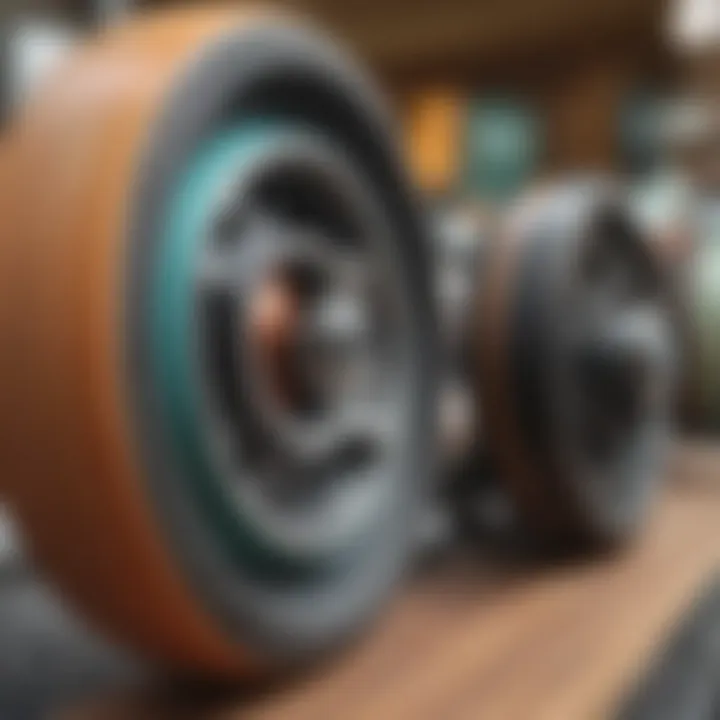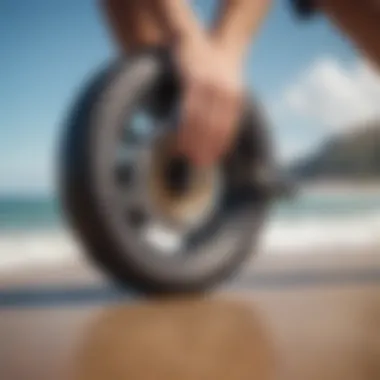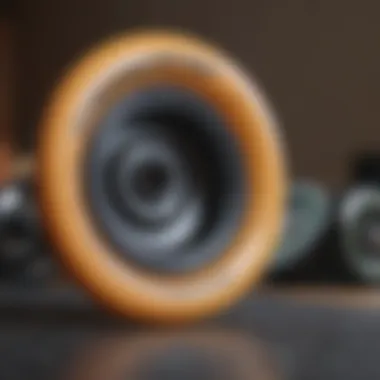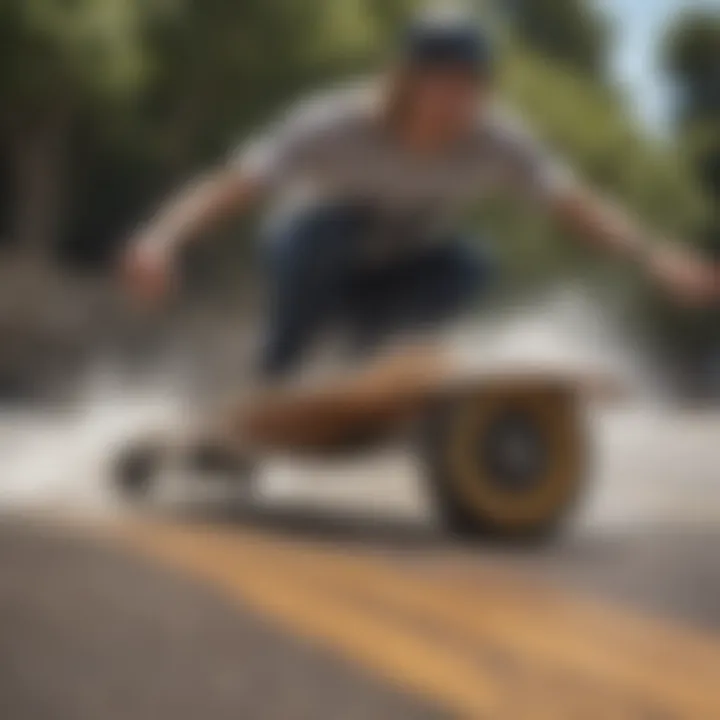Expert Guide to Choosing Longboard Wheels for Sliding


Intro
Selecting the right longboard wheels can feel like a daunting task, especially for those who are new to the sport of sliding. It's not just about picking something that looks good; it’s about understanding how different wheels can influence your performance, control, and overall experience. The diversity in wheel types, sizes, and materials means that what works wonders for one rider could be completely off for another.
Moreover, the subtleties of tire durometer can have a significant impact on your ability to slide smoothly. You may have heard seasoned riders mention how a harder wheel can provide more speed while a softer one offers better grip and slide control. But how do you decipher these differences? This guide aims to demystify the complexity behind longboard wheels and tackle common misconceptions.
Longboard wheels are more than just a pretty face on a board; they’re essential to sliding performance and rider confidence.
Whether you’re an eager beginner learning the ropes or a veteran looking to refine your skills further, grasping the key concepts around wheel selection is vital. The physics behind sliding also play a crucial role in enhancing your technique and skills. By the end of this exploration, you will have a better understanding of how to craft your riding experience to align with your unique style and preference.
In the sections ahead, we will dive deeper into the types of longboard wheels available, the essential factors to consider when making a selection, and the practical tips that can help you master sliding. Prepare to take your longboarding to the next level.
Intro to Longboard Wheels
When speaking about longboarding, wheels might not seem like the highlight of the conversation at first glance. However, they are pivotal to a rider's experience, especially when it comes to sliding techniques. Understanding longboard wheels is akin to knowing the right tools for a sculptor; the better the knowledge, the more finesse can be executed. This section illuminates key aspects of longboard wheels that every rider - from beginners to seasoned veterans - should grasp.
The Evolution of Longboarding
Longboarding has come a long way since its humble beginnings in the 1950s and 60s. Originally crafted from old roller skate wheels and planks, the design has evolved tremendously. Nowadays, manufacturers are consistently pushing the envelope regarding materials, designs, and technology. For instance, contemporary longboards often feature precision-engineered urethane wheels that make those old wooden contraptions look like mere toys.
Take the advent of polyurethane wheels: these have transformed grip and durability in ways we couldn’t have imagined decades ago. In a world where speed and control are crucial, advancements in wheel technology have significantly changed the game.
Purpose of Longboard Wheels
Longboard wheels serve various purposes, each tailored to enhance the rider's experience. Some key functions include:
- Stability and Control: Larger wheels provide better stability for a smoother ride, especially on uneven terrain.
- Grip and Slide: The right durometer rating determines how much grip a wheel provides. Softer wheels are better for grip while harder wheels excel in slides.
- Durability: Materials like urethane resist wear and tear, ensuring that the wheels last longer under heavy use.
In summary, understanding longboard wheels is fundamental for anyone looking to master the art of sliding. A rider’s skill, safety, and overall joy in sliding come down to how well they understand their wheels. Not only does it enhance their sliding technique, but it also significantly impacts their performance during rides.
"The right wheels can make the difference between a gliding experience and a bumpy ride. Knowing what to choose is fundamental."
In the following sections, we will delve deeper into the specifics of wheel size, durometer ratings, and materials. Each aspect plays a critical role in overall performance, leading to a more fulfilling ride.
Understanding Sliding
Sliding on a longboard is more than just a flashy technique for showing off. It's integral to how riders maneuver, control, and maintain speed during their rides. Whether you're zipping down a steep incline or carving through tight turns, understanding sliding can elevate your overall longboarding experience. It’s not simply about knowing how to do it; it’s about grasping the full spectrum of benefits that effective sliding provides.
When you slide, you are engaging with the dynamics of speed and friction, creating a balance that, if mastered, allows for increased control over your board. This is crucial for navigating sharp corners or uneven surfaces, minimizing risks, and maximizing the thrill of the ride. A skilled slider can also conserve kinetic energy, which translates to smoother transitions and sustained speeds. Moreover, understanding sliding helps in reducing wear on wheels and other components, prolonging their lifespan.
Experience and technique play significant roles here. A rider's skill level directly impacts their ability to execute slides effectively. Beginners might find themselves struggling against their own momentum, while seasoned riders glide with ease. This difference becomes particularly relevant when selecting appropriate equipment, as the wrong wheels or setup can hinder progress.
“Efficiency in sliding can transform your ride from mundane to magnificent.”
The aspects of sliding, including body positioning, the angle of the board, and how weight is distributed, collectively shape a rider's style. Riders often experiment with different techniques, finding what suits their comfort and the specific conditions they ride in. The more knowledge one acquires about these elements, the more flexibility they have in their riding style.
What is Sliding?
At its core, sliding is the process of intentionally losing traction between the wheels and the surface beneath the longboard. This controlled loss of grip allows for sharper turns and smoother transitions while maintaining speed. Imagine a car taking a corner too fast; it might drift before regaining control. Similarly, sliding on a longboard momentarily shifts the wheels from grip to slip without completely jeopardizing equilibrium.
Different sliding techniques are utilized based on the rider's preference and the riding conditions. Some common styles include:
- Stand-Up Slides: Riders shift weight to their heels or toes to engage the slide, lifting the board sideways to scrub speed.
- Coleman Slides: A term coined after the first rider to popularize it, involving a cross-arms motion for smoother transitions.
- Toeside and Heelside Slides: These terms refer to which edge of the board the rider shifts their weight onto during a slide.
Mastering these techniques can notably elevate a rider’s performance, especially in competitive scenarios. Besides technique, the material and type of wheels also significantly impact a rider's ability to slide effectively.
The Physics Behind Sliding
Understanding the mechanics of sliding involves a cogent grasp of basic physics principles such as friction, inertia, and momentum. When a rider initiates a slide, they manipulate these forces to their advantage.


Friction, in this context, is a double-edged sword. On one hand, it is essential for maintaining grip during normal riding; on the other, it is the force that needs to be overcome during a slide. The balance between these opposing forces determines how well a rider can execute a slide. Worn down wheels may not provide enough friction, leading to difficulty in control. Conversely, too much grip can prevent a slide altogether.
Additionally, momentum plays a crucial role as well. A rider's speed contributes significantly to the dynamics of sliding. The faster a rider approaches a turn or a stop, the more momentum they must manage. This translates to the sliding technique needing to adapt depending on the rider's speed.
Several parameters can influence the sliding experience:
- Wheel Durometer: The hardness of the wheel affects its ability to grip or slide.
- Surface Quality: Rough surfaces may allow for longer slides compared to smoother ones.
- Body Weight and Distribution: Heavier riders might need to modify their technique compared to lighter riders due to differing inertia.
Understanding these elements is key to mastering sliding, granting riders the insight to tailor their techniques and equipment choices for an optimized experience.
Key Wheel Specifications
When it comes to longboarding and, specifically, sliding, the wheels you choose can make or break the experience. Each specification of the wheel plays a pivotal role in how smoothly and efficiently a ride goes. Here, we delve into aspects such as size, durometer ratings, and shape, breaking down how they interrelate and impact overall performance.
Wheel Size Considerations
Diameter and Its Impact on Performance
The diameter of a wheel is more than just a number; it’s central to how well a longboard performs. Larger wheels, typically measuring from 65mm to 75mm, can roll over cracks and uneven surfaces with more ease, creating a smoother experience. This is crucial when you’re trying to maintain control while sliding, as any abrupt changes in terrain can lead to a loss of balance.
Conversely, smaller wheels, around 50mm to 60mm, offer increased responsiveness and agility, allowing for tighter turns which is often favored by seasoned riders looking for precision in sliding techniques.
The crucial aspect here is not just the size, but how it influences speed and momentum. Larger wheels retain energy better, making them suitable for downhill slides as they maintain speed longer despite the friction. Smaller ones, however, can be ideal in urban settings or tight courses where sharp turns are necessary. This characteristic can be a deciding factor in whether you should pursue a smoother long run or quick corners and agility.
Comparison Between Large and Small Wheels
Diving deeper, comparing large and small wheels reveals some fascinating contrasts. Both types have distinct characteristics that make them suited to different riding styles. Larger wheels sail over obstacles and provide a comfortable ride, often emerging as the go-to choice for cruising and downhill riding. Yet, they introduce some challenges in terms of control at very low speeds, which might not be optimal for novice riders exploring their sliding techniques.
In contrast, small wheels excel in gripping and performing tricks, often giving riders remarkable responsiveness. This makes them appealing for those who wish to explore technical slides and complex maneuvers. However, they tend to struggle on rough terrains; thus, it’s a balancing act dependent on your primary riding style and the surfaces you typically ride on.
Durometer Ratings
Understanding Hardness Levels
Durometer ratings provide insight into the hardness of the wheel material, with lower numbers indicating softer wheels and higher ones denoting stiffer options. For example, a durometer of 78A is much softer than 101A. Softer wheels offer enhanced grip, making them ideal for beginners learning to slide, as they allow for better traction on the pavement.
However, softer wheels can wear out quicker, and their ability to absorb shocks is limited, especially on rough surfaces. In contrast, harder wheels tend to slide more easily and resist flat spots, which could present a better long-term investment for those who slide frequently.
How Durometer Affects Grip and Sliding
The relationship between durometer and sliding cannot be overstated. A wheel’s hardness directly influences how it behaves during a slide. Softer wheels generally excel in maintaining grip, allowing for more controlled slides and better retention when attempting tricks or navigating sharp turns. As such, they often become the preference for casual sliders or those focused on stability.
In contrast, harder wheels facilitate longer, smoother slides but can be tricky for less experienced riders to manage while still offering the advantage of speed. Thus, choosing the correct durometer rating boils down to matching the wheel hardness to the rider's skill level and intended riding style.
Wheel Shape and Design
Different Profiles for Diverse Riding Styles
The shape of the wheel also contributes significantly to performance. For instance, square-edged wheels provide consistent grip and tend to slide perfectly, making them indispensable for those focused on tricks. On the flip side, wheels with rounded profiles offer a easier ride and prevent unexpected catches on the ground, lending themselves well to cruising and casual riding.
This diversity in wheel profiles allows riders to tailor their longboarding experience, choosing wheels that fit their specific style, whether they are carving, sliding, or doing casual commutes.
Beveling and Its Effects on Sliding
Now, let's touch on beveling—the design aspect where the edges of the wheels are angled or rounded off. Beveling plays a role in performance, especially in sliding. Typically, wheels that have a slight bevel provide less chance of catching during a slide, allowing for smoother transitions and better control. This feature makes them favorable if you're looking to get a more fluid sliding experience.
In contrast, non-beveled, square wheels offer maximum grip and a more anchored feel, which could lead to a bit more resistance during slides, perhaps lessening your ability to perform lengthy glides.
In sum, each of these specifications—from size and durometer rating to shape and bevel design—serves a critical function in the art of sliding on a longboard. Recognizing and understanding these factors aids in making informed choices that will enhance your riding experience.
Materials and Manufacturing


The choice of materials and manufacturing methods in longboard wheels holds significant weight in determining their overall performance during sliding. When you're carving down a hill or gliding smoothly across pavement, the wheels act as the crucial connection between your board and the ground. Understanding various materials and processes not only enhances riding experience but also affects durability and feel. Each material behaves differently under various conditions.
Common Wheel Materials
Urethane Versus Plastic
When we talk about longboard wheels, there's a classic showdown between urethane and plastic. Urethane has become a favorite among riders due to its elasticity and grip. It tends to hug the pavement, providing a smooth ride that's vital for sliding. On the other hand, plastic wheels can often lead to a bumpy experience. Their hardness can introduce unwanted vibrations.
- Advantages of Urethane:
- Disadvantages of Plastic:
- Better grip on surface, great for control in slides.
- Absorbs shock well, enhancing comfort.
- Can lead to faster wear-and-tear.
- Slippery on wet surfaces, making them less versatile.
Plastics might be cheaper, yet they lack that feel urethane provides. If good sliding performance is the goal, urethane wheels are the way to go. Their unique properties make them the most popular choice among longboarders.
Recycled Materials and Sustainability
In today's world, there's a growing conversation around sustainability. More companies are turning to recycled materials in wheel production. This not only helps in reducing waste but also provides solid performance similar to traditional materials.
- Key Characteristic:
- Advantages:
- Environmentally friendly, keeping plastic out of landfills.
- Reduces carbon footprint.
- Offers comparable performance without harming the environment.
Many consumers appreciate the dual benefit of achieving top-notch performance while also contributing to a greener planet. It's a win-win situation for both riders and the environment, bolstering the perception of recycled materials as being progressive choices in wheel manufacturing.
Manufacturing Processes
Cast vs. Milled Wheels
The debate between cast and milled wheels is akin to choosing between bread and butter—both have their place, but the choice depends on what one desires in a ride.
Cast wheels are created by pouring urethane into a mold. This leads to a more uniform structure but can sometimes compromise the overall precision in shape. Cast wheels tend to be good for beginners since they offer durability at a lower price.
Milled wheels, on the contrary, are crafted from a solid piece of material, which allows for greater control over design and specifications, leading to better performance in sliding.
- Advantages of Milled Wheels:
- More precise shapes can cater to specific riding styles.
- Typically stronger and more resilient in the long run.
However, milled wheels often come at a higher price, but they deliver unmatched performance, especially in demanding conditions.
Quality Control in Production
Quality control during the production of longboard wheels is essential for ensuring safety and performance. Rigorous checks can prevent the release of flawed products into the market that would lead to decreased rider control or safety hazards.
- Key Differences:
- Good quality checks mean a consistent product.
- Inconsistencies can lead to premature wear and reduced performance.
Investing in wheels that undergo strict quality control provides peace of mind for riders, assuring that their gear is built to withstand both regular usage and the rigors of sliding. Riders often emphasize the importance of choosing brands known for diligent quality practices in production.
"Quality over quantity holds true, especially when it comes to gear that supports your passion."
Understanding these materials and manufacturing processes equips riders to make informed choices that enhance their longboarding experience, paving the way for thrilling slides and rides ahead.
Selecting the Right Wheels for Sliding
Choosing the correct longboard wheels for sliding is more than just a simple task; it’s akin to picking the right shoes for an athletic event. The feel, performance, and overall experience hinge significantly on this decision. The dynamics of a skater's ride can change drastically based on wheel specifications. Not only do the right wheels influence sliding skills, but they also contribute to stability and control.
Factors to Consider


Rider Skill Level
Understanding the rider's skill level is crucial in selecting wheels. Beginners often prefer softer wheels due to their forgiving nature. These provide better grip and comfort, crucial for someone still getting their bearings on a longboard. A key characteristic of softer wheels is their ability to absorb vibrations and shocks, which can enhance confidence.
On the flip side, experienced riders may lean towards harder wheels. These provide less grip, offering greater slide potential, which is something advanced riders seek for tricks and techniques. However, the unique feature of these hard wheels is that they can be tricky to control for newcomers, leading to potential wipeouts and harsh learning curves.
Conditions and Environments
The riding conditions and environments play a pivotal role in wheel selection. A smooth asphalt road will demand different wheels than a bumpy, uneven pathway. For instance, hard wheels thrive on smooth surfaces, allowing for swift slides and faster speeds. A noteworthy characteristic of these wheels is their ability to maintain speed through slides, which is the sweet spot for many experienced riders.
Conversely, softer wheels shine on rough surfaces. They cushion against cracks and imperfections, ensuring a smoother ride. This is beneficial for zipping around city streets or cruising at the beach where street conditions can vary. The downside? They may not roll as fast and can dissipate energy quicker, meaning a rider's speed will be sacrificed in favor of comfort and grip.
Recommendations for Beginners
For those just starting out, don’t bite off more than you can chew. Opt for softer wheels, generally around 78A to 83A durometer rating. They provide the traction and stability that new riders need. A recommended size is typically between 55mm to 60mm in diameter, ensuring they can handle various terrains while still being light on the board.
Advanced Choices for Squared Riders
For those advanced skaters looking to refine their skills, harder wheels, anything from 84A and above, come into play. The wheels offer unique ways to slide and control speed. Wheel profiles that are narrower can also be beneficial, making them nimble and responsive for more intricate tricks. Riders familiar with techniques may consider experimenting with wheel shapes designed specifically for sliding, which can add an extra layer of cooldown after intense rides.
"The right wheel can elevate a boring session into an exhilarating dance with gravity."
Common Misconceptions
Understanding longboard wheels, especially in the context of sliding, requires more than just technical knowledge; it involves unpacking a few widely held misconceptions that can hamper a rider's skills and abilities. Misconceptions can lead to poor choices in wheel selection and ultimately affect the overall experience of sliding. In this section, we will clear the air around two major misconceptions: the belief that wider wheels are always superior and the idea that hard wheels are a one-size-fits-all solution. By addressing these common misunderstandings, riders can make more informed decisions and tailor their setups to fit their unique style and environment.
Wider Wheels Are Always Better
One common myth floating around in the longboarding world is the notion that wider wheels automatically translate to better performance. This stems from the idea that a larger surface area increases grip, leading many riders to gravitate towards the widest options available. However, the reality is a bit more nuanced.
Wider wheels do provide a larger contact patch, which can enhance stability, especially at higher speeds. But, there's a catch. Wider wheels can also increase resistance during turns, limit maneuverability, and require more effort to initiate slides. In essence, while they might offer solid grip, they can compromise the flow and finesse that some riders prefer.
Take, for instance, two riders: one downhilling on steep mountain roads and another cruising through a crowded skate park. The first may benefit more from wider wheels that give considerable grip on high-speed descents, while the second might find that narrower wheels allow for quicker turns and a snappier feel. In short, it's crucial to match wheel width to one’s intended riding style rather than simply opting for what seems to be better.
Hard Wheels Are Ideal for Everyone
Another misbelief is the idea that hard wheels are suitable for every rider, regardless of the situation. This misconception often arises from the general assumption that harder materials offer better durability and speed. While hard wheels can indeed be beneficial, particularly in smooth conditions or for fast sliding, they are not universally ideal.
Hard wheels provide less grip on rough terrain and can translate vibrations to the rider, leading to a less comfortable ride. For sliding, they may facilitate smoother transitions and less drag, where a light touch is needed to break free of grip. But on rough surfaces, softer wheels are the sweetheart. They mold better to the uneven ground, allowing for a smoother ride while still providing significant control.
When selecting wheels, one should always consider the riding conditions and personal preferences. Experimentation is key. A rider might start with a softer durometer and gradually make their way to harder options, finding a balance that complements their unique style.
It’s essential to demystify these widespread beliefs to enhance your longboarding experience. Both wheel choice and rider skill contribute significantly to sliding performance – there's no universal "best."
In summary, when it comes to longboard wheels, understanding these common misconceptions allows riders to make better choices aligned with their personal preferences and riding environments. This way, they can truly optimize their sliding experience.
End
In this exploration of longboard wheels specifically tailored for sliding, we’ve covered a fair bit of ground. The conclusion provides a moment to tie everything together, emphasizing the entwined elements of wheel specifications, materials, and rider considerations that together shape performance and control.
Summarizing Key Points
First off, we must revisit a few essential points.
- Wheel Size Matters: The diameter of longboard wheels significantly influences speed and stability. Larger wheels are better for maintaining momentum on rough surfaces, while smaller wheels often suit technical maneuvers.
- Understanding Durometer: The hardness of wheels affects grip, with softer durometers yielding better traction but potentially less sliding ease. Knowing the right durometer for your style can enhance your ride.
- Shape and Design: Not all wheels are created equal. The profile and design of the wheel play vital roles in sliding dynamics. Cyclists often opt for conical shapes for stability during slides.
- Material Composition: Most wheels are made from urethane for durability and performance. Exploring eco-friendly options can also promote sustainability in skating.
- Skill Level Influence: Choose according to your level. Beginners may benefit from larger, softer wheels to ease their entry into the sport.
Collectively, these aspects not only influence sliding technique but also contribute to a richer, personalized riding experience.
Encouraging Exploration and Experimentation
Now that you've got the foundational knowledge, don't hesitate to explore and experiment. Longboarding is as much about individual preference as it is about mechanics. As each rider has a unique style, it stands to reason that wheel preferences will vary widely.
Take time to try different wheel types when you can. Some riders find that they improve by simply testing various setups. Join communities, engage on platforms like reddit.com where passionate riders share insights, and borrow different setups from friends. Exploring various conditions—smooth pavement, rough terrains, and hilly slopes—will also contribute to your comprehension of how wheel characteristics change the ride.
Also, document your observations after trying different wheels. Things like how they felt during specific maneuvers or how they handled under varying weather conditions keep you in tune with your gear, and help in making more informed choices in the future.
In short, there’s no one-size-fits-all in longboarding. So, roll with your instincts, think critically about choices, and let the wheels guide you to new adventures on the pavement.















